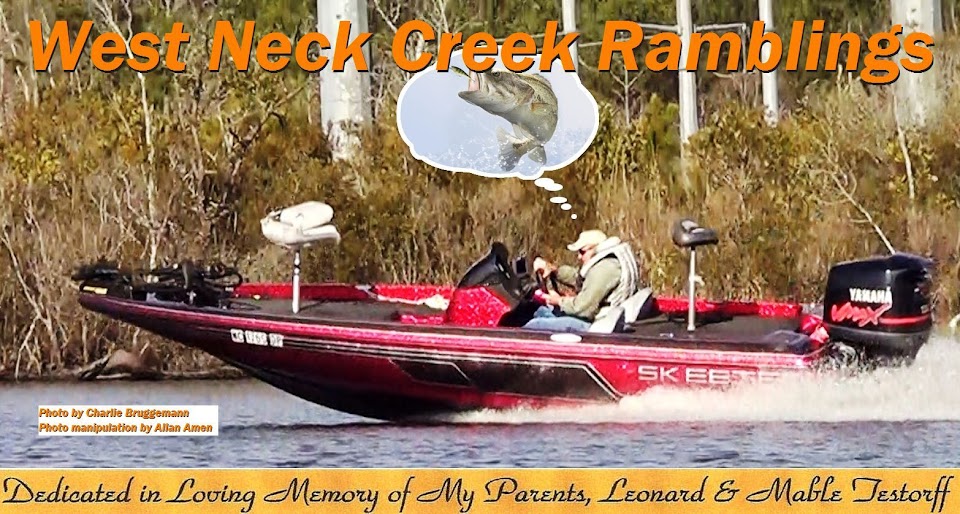Haven't owned one of these since the early '70s, mainly because I couldn't figure out how to mount a winch on the front of my boat to crank the lure back in after making a cast. All kidding aside, this is one of those lures that'll put you at parade rest if you throw it very long.
I gave the only two or three I ever had to my pop, who was a hoss of a man in his prime. He used 'em a bit in the strip-mining pits around my hometown but, like me, quickly concluded they weren't worth the effort you had to expend while using one.
It's abundantly evident, however, that not everyone shared our conclusions about the mudbug. From the moment this lure was introduced in 1968, it created quite a stir. It resembled a crawfish in appearance, even to the extent of being retrieved backward, to simulate a fast-moving or retreating crawfish. A winner in numerous bass-fishing tournaments, this deep-diver was available in five different sizes for fresh and saltwater fishing by 1980.
The man responsible for bringing this lure to the market, of course, was none other than Fred Arbogast, one of the true pioneers of the fishing-lure industry. As true of so many who have entered the lure business over the years, Arbogast first got into it as a hobby.
He started out carving lures for himself and friends while employed by the Goodyear Tire and Rubber Co. in his hometown of Akron, OH. As his lures began catching on with area anglers, some local tackle-shop owners started asking if they could buy the lures to sell in their stores.
Arbogast soon realized he was on to something, and armed with this newfound popularity and confidence in his lures, he resigned from Goodyear and, in 1926, entered the lure business in earnest. Two years later, the Fred Arbogast Co. officially was borne.
The Arbogast mudbug, a cousin of the old Bomber, is one of the all-time favorite crawfish-imitating crankbaits. It's also one of the first baits to have a lineup of colors that included chartreuse--a hot item in tackle stores across the country at the time.
Its wide wiggle, with a quick-diving angle, created a hard-vibrating action and enabled the mudbug to bump the bottom in 8 to 10 feet of water. Once on the bottom, this metal-lipped bait (one of only three in existence at that time) stayed put, stirring up the mud and attracting bass (hence its name). This unique action made it a big-fish favorite of serious anglers (see accompanying photo of a young lad with his 7-lb. 11-oz. bass he caught at Lake Fork on a mudbug). Now it's a favorite attraction among collectors everywhere. The lure's floating ability allowed it to back out of heavy cover on a slack line, eliminating potential hang-ups, where old metal lures wouldn't.
Mudbugs were a proven winner when it came to early-spring fishing, a time when big bass are in a pre-spawn mode and crawfish are starting to appear. Old-timers believed heavy line was a must when fishing this lure, regardless of which model you were using. (The model no. G22 weighed 5/8 oz. and was a favorite for big-bass fishermen who wanted to stay in contact with the bottom. Meanwhile, the model no. G20 weighed 1/4 oz. and was designed to fish depths of 4 to 6 feet.)
According to an online account by writer-fisherman Dan McGarry, the mudbug is best used in two situations. "Put your boat in 3 to 5 feet of water and cast out into 20 feet or deeper (the most effective range is weeds in 10 to 15 feet of water)," he said. "Try to cast at a 45-degree angle to maximize lure coverage and to not drive your partner crazy. As you move along, pay attention to when and where strikes occur--very rarely do you only catch one in an area. Every time you cast, pay attention to anything that will give you a reference point to return the bait to the same area.
"Crank the bait about six or seven good, hard turns down, then slow up when you feel the bait strike weeds, rock, brush, or bottom. Stop and count to three; you will feel the bait moving away and up. A bass will just blast the bait, or it will feel like a worm hit--he'll just swim off with it in his mouth.
"One thing that always happens is the best bass will hit as the bait starts its arc up from the bottom, or at the end of the retrieve. And they always swim to the boat with a little inside-outside roll. Rod position is very important to avoid fatigue. Keep the rod low, and only put slight pressure on the rod by changing the angle and using the reel to winch the bait along."
The second ideal situation in which to use a mudbug, according to McGarry, "is exceptionally windy days, when a jig bite is hard to feel. Fish upwind, making long, low casts along the bank, on rocky flats in 3 to 6 feet of water. I just have the (trolling) motor on high and buzz the bait along, allowing it to bounce and deflect off of every object. The final mudbug method I use is the ricochet method, in which I take the bait and purposely try to crash it through shallow-water and deep-water thick cover. Bass will turn down worms and jigs to blast an alien monster that slams into their tree."
The mudbug is no longer available, but it can be found for sale on eBay and other auction sites. Get one and try it, if you haven't already. The mudbug is just one more Fred Arbogast lure that has brought pleasure to fishermen all over the world.



.jpg)
No comments:
Post a Comment